Stone is one of the predominant materials used for house exteriors today. Whether your home’s style is colonial, traditional or contemporary, stone lends a timelessness and an organic connection to the earth. But stone homes in the U.S. have historically had an austere look, sitting atop the landscape with little or no connection to their foundation plantings, let alone their gardens. Let’s look at ways to make your stone home feel at home in your landscape.
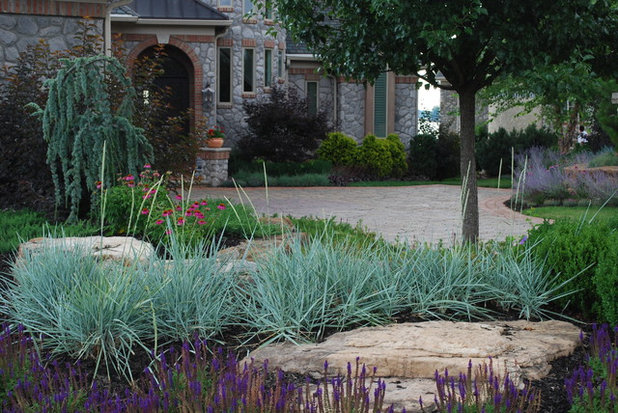
Jay Sifford Garden Design
Consider how to design a purposeful landscape. While foundation plantings of green boxwood and hollies may be the norm in suburbia, Houzzers want and deserve something more. What works for your neighbor’s home may not work for yours. To make your home feel truly at home in your landscape, begin by taking an objective look at its style, siding, coloration and textures.
This house, covered in gray stone and brick in tones of pink and orange, appears to be happily nestled on its lot because careful attention was paid to color and texture. The blue and purple tones of the lyme grass, Russian sage and purple salvia pull from the stone; their verticality speaks to the height of the home. The pink coneflowers pull from and brighten the tones in the brick, while the texture introduced by the blue atlas cedar visually reinforces the texture of the stone.
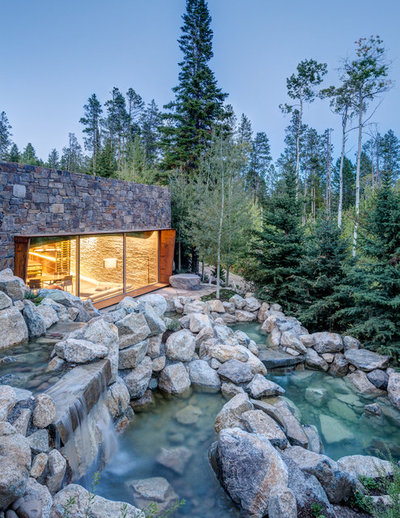
Carney Logan Burke Architects
Add boulders. It may at first seem counterintuitive to add more stone to a landscape that surrounds a house of stone, but doing so can ground the home in a meaningful way by visually pulling it forward into the space. Make sure to match the scale of the boulders to the scale of the house. Undersize boulders can look like an afterthought, or worse yet, a weekend DIY project gone awry.
The many boulders in the landscape shown here accentuate the concept of juxtaposition by giving the appearance of deconstruction. Additionally, the water softens the vignette by adding a sense of flow and continuity.
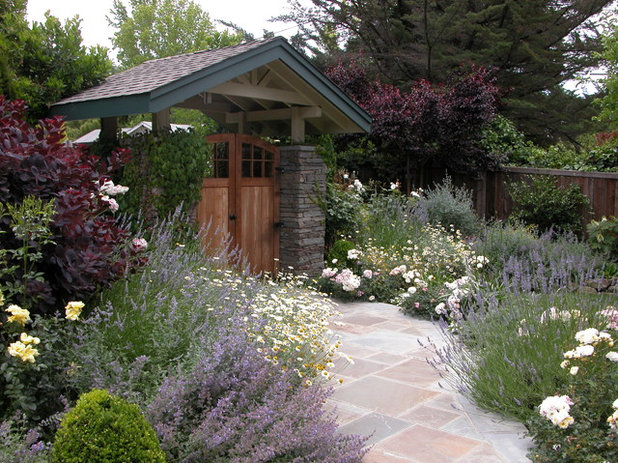
Avant Garden
Consider an entry gate or fence. What better place to set the tone for your home than at its entrance? By doing so thoughtfully, you can pull your home’s color, texture and style forward in smaller doses to encourage curiosity, exploration and the sense that your home is a special place. I realize that not all of us have the space or homeowner’s association approval to do such things, but if possible, make that connection by adding an appropriate gate or fence using the same stone.
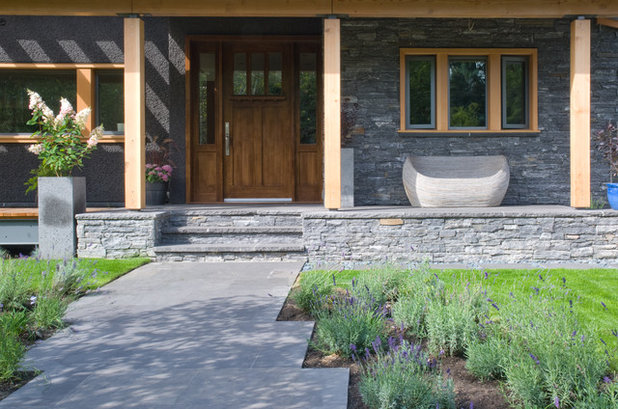
Houston Landscapes
Rethink your sidewalk. As unimaginative as they are, concrete sidewalks seem to be the norm in many corners of suburbia. A unique sidewalk, however, can give your entry a sense of anticipation and a homogenous feeling. This bluestone sidewalk, laid out in a contemporary zigzag pattern, pulls the color and texture of the home forward and into the landscape, making a meaningful connection. Regardless of your stone’s coloration, a trip to a good local stone yard will yield several types of paver stone that will work for your home and landscape. Perhaps your sidewalk can easily be resurfaced with an appropriate stone.
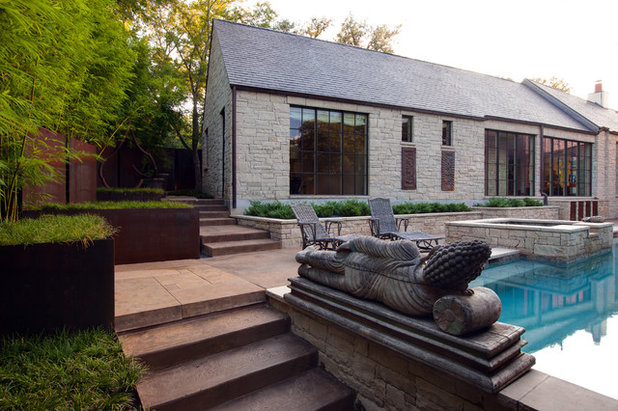
Hugh Jefferson Randolph Architects
Consider garden sculpture. Thoughtfully placed garden sculpture can create a sense of journey and anticipation when visitors arrive. Several pieces used in conjunction can create rhythm to further build anticipation.
Notice how the Asian piece shown here connects with the house, not with the patio paving, pulling the color and texture of both the siding and the roof into the landscape.
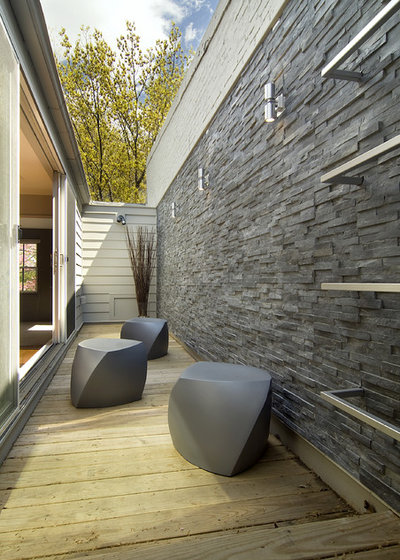
KUBE architecture
Purchase new patio furniture. Perhaps that old metal mesh patio table and chairs worked with your previous house, but now they look tired and out of place at your current home. It may be time to recycle and upgrade.
Notice how these contemporary gray cubes pull this home’s color and texture down onto the deck while speaking to the clean lines of the home. Would they work with a traditional home? No, but they sure pull their weight here, and they do so with style.
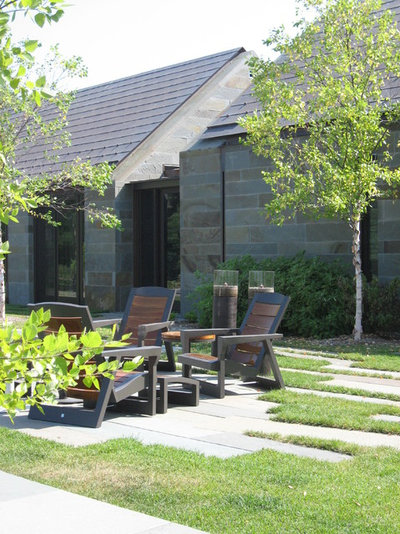
Martin Patrick 3
This set of chairs complements this stone home perfectly. Notice how the chairs contain both the gray and brown tones of the stone house exterior. Additionally, the shape of the chairs mimics the shape of the siding. The linear stone patio planks continue the theme and ground the furniture.
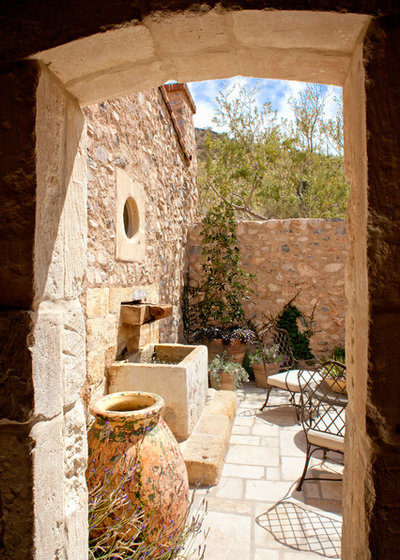
Don Ziebell
Add planters and pottery. Terra-cotta and ceramic pots come in a variety of colors and textures, and you can certainly find one to complement the stone on your home. Notice how this piece of pottery pulls the orange and gray tones from the stone as well as repeats the texture of the home’s exterior.
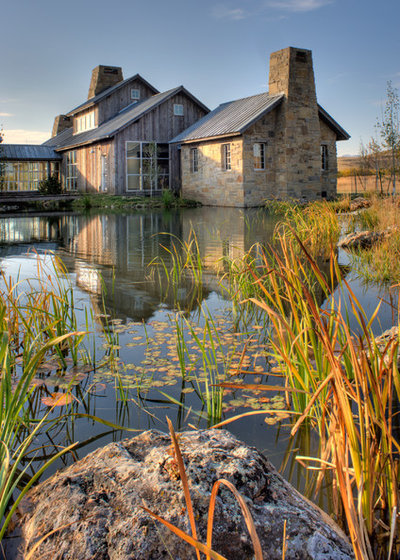
JLF & Associates, Inc.
Don’t neglect seasonal interest. Gardeners are a special breed of people who have learned to embrace seasonal change. Why not capitalize on those changes by purposefully connecting them to your home? This garden is a case in point. Notice how the lake reflects the home, politely taking possession of it and grounding it. Then notice how the boulder in the foreground repeats the texture of the home’s stone siding. Finally, the seasonal orange coloration of the grasses pulls the orange tones of the stone into the landscape for a perfect seasonal composition.
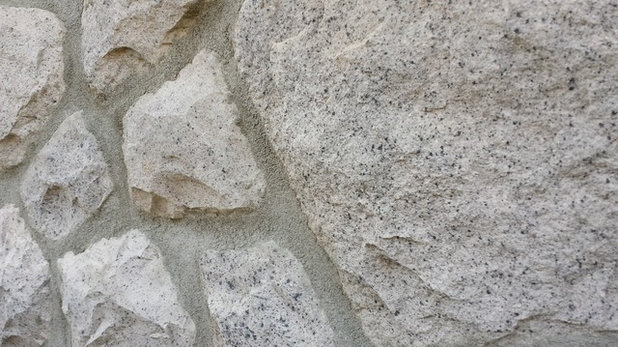
Jay Sifford Garden Design
How to StartLet’s work with this gray stone wall. Near-blacks, blues, burgundy and bright pink would pair well with it. Well-suited companion plants for this type of stone include Grace smoke tree (
Cotinus ‘Grace’,
USDA
zones 5 to 9), Ever Red fringe flower
(
Loropetalum chinense ‘Chang Nian Hong’,
zones 7 to 9),
purple sage (
Salvia nemorosa cvs, zones 5 to 9), Russian sage
(
Perovskia atriplicifolia cvs, zones 4 to 9), Crimson Queen Japanese maple
(
Acer palmatum var.
dissectum ‘Crimson Queen’
, zones 5 to 8),
Dallas Blues switchgrass (
Panicum virgatum ‘Dallas Blues’, zones 4 to 9),
Blue Star juniper (
Juniperus squamata ‘Blue Star’, zones 4 to 8),
Black Negligee snakeroot (
Actaea simplex ‘Black Negligee’, zones 3 to 9),
cheddar pinks (
Dianthus gratianopolitanus ‘Firewitch’, zones 3 to 9) and burgundy
coleus (
Solenostemon scutellarioides cvs,
zone 11).
Accent colors for ceramic pottery and accessories would be in tones of blue and bright pink. If your aesthetic leans more toward terra-cotta, look for pottery that includes more pink than orange tones. Stainless steel sculpture would be at home with this stone too.
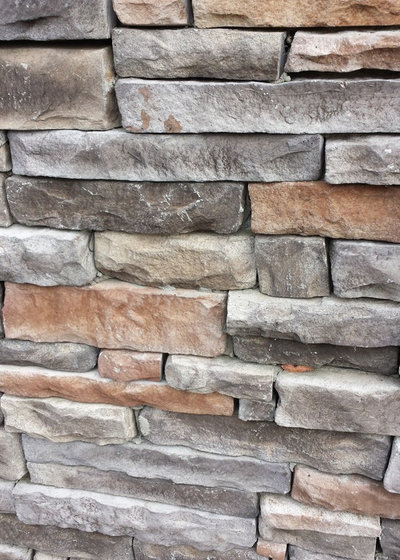
Jay Sifford Garden Design
This cultured stone is a fabricated product that includes tones of gray and orange with plum accents. Companion plants for this type of product include
Orange Rocket barberry (
Berberis thunbergii ‘Orange Rocket’, zones 4 to 9),
Wine & Roses weigela (
Weigela florida ‘Alexandra’, zones 4 to 8),
Coppertina ninebark (
Physocarpus opulifolious ‘Mindia’, zones 3 to 8),
Apache Sunset giant hyssop (
Agastache rupestris ‘Apache Sunset’, zones 6 to 9),
Crimson Fire fringe flower (
Loropetalum chinensis var.
rubrum ‘PIILC-I’,
zones 7 to 9), and
Orangeola Japanese maple (
Acer palmatum var.
dissectum ‘Orangeola’, zones 5 to 8), in addition to Blue Star junipers and and Firewitch cheddar pinks.
Accent colors for ceramic pottery and accessories would be in tones of blue and orange. If you prefer terra-cotta, look for pieces that lean more toward orange than pink. Either stainless steel or rusted steel sculpture would be appropriate for this stone.





